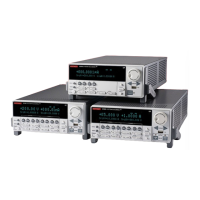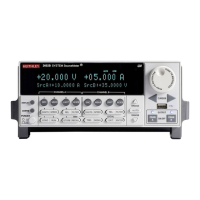2-40 TSP Programming Fundamentals Series 2600 System SourceMeters Reference Manual
2600S-901-01 Rev. A / May 2006 Return to Section 2 topics
Displayed messages and input prompts are used in scripts to prompt the operator
to enter parameter values from the front panel. See “
Interactive script” (later in this
section) for more information.
User scripts
User scripts can be written using your own program or the Test Script Builder.
User scripts are loaded into the Series 2600 and can be saved in non-volatile
memory. Scripts not saved in non-volatile memory will be lost when the Series
2600 is turned off.
Script examples
Script using commands and statements only
The script in Table 2-1 sweeps voltage (1V to 5V) and measures current at each
step. The five current readings are returned to the host computer:
Table 2-1
Example script to sweep V and measure I
Test Script Builder User’s Program Script
loadscript
current = {} current = {}
smua.source.output = smua.OUTPUT_ON smua.source.output = smua.OUTPUT_ON
for j = 1, 5 do for j = 1, 5 do
smua.source.levelv = j smua.source.levelv = j
current[j] = smua.measure.i() current[j] = smua.measure.i()
print(current[j]) print(current[j])
end end
smua.source.output = smua.OUTPUT_OFF smua.source.output = smua.OUTPUT_OFF
endscript
NOTE When creating a script using the Test Script Builder, only
the chunk is typed in as shown above. See “
Using Test
Script Builder” earlier in Section 2 for details on creating,
loading and running the script.
When creating a script using a programming language,
shell commands must be included to manage interactions
between the host computer and TSP. The
loadscript
command loads the script into the Series 2600 and
endscript signifies the end of the script.
